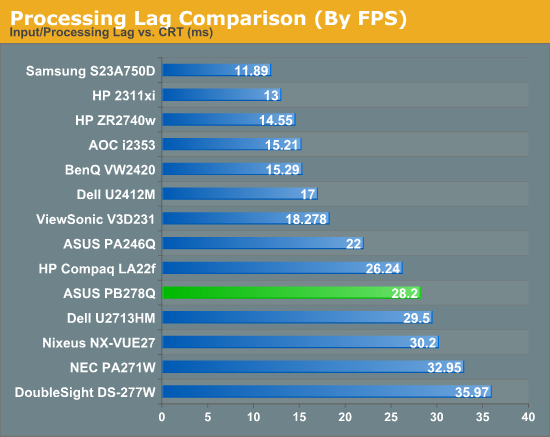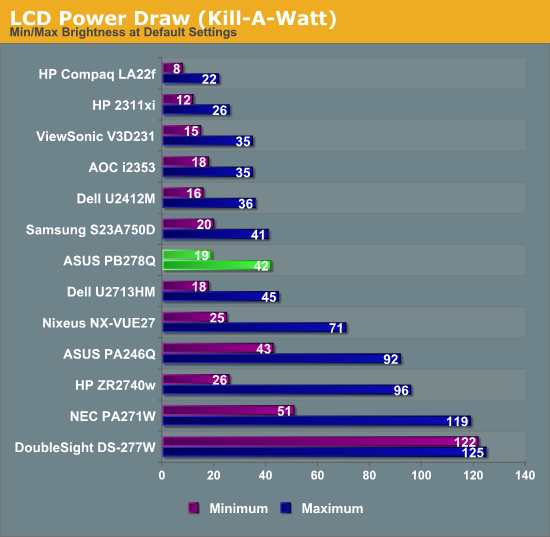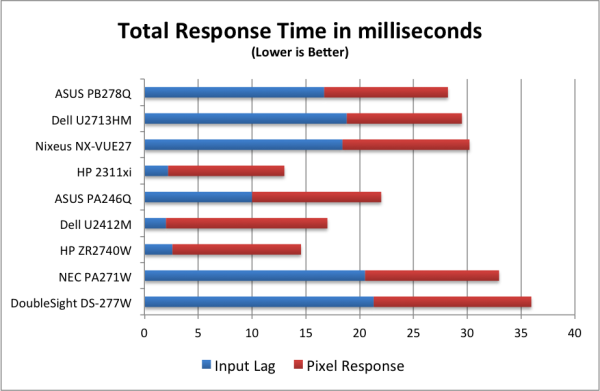ASUS PB278Q Review: An IPS Competitor Emerges
by Chris Heinonen on November 19, 2012 11:00 PM ESTASUS PB278Q Input Lag and Power Use
Unlike the prior 27” displays that we've tested, the ASUS has a 1:1 pixel mapping mode and a full stretch mode for 1920x1080 content. This finally allows me to test and see if the issue with higher lag on 27” displays is being caused by stretching the 1920x1080 signal to fill a 2560x1440 screen, or if it's the inputs and other hardware causing the issue. The lag numbers for the PB278Q are right about what we’ve been seeing for 27” displays, with 16.7 ms of input lag and 11.5 ms of response time for the pixels. This gives us a total overall delay of 28.2 ms using the DVI input. Switching from Full to 1:1 gives no change in the results at all.
Because of this, it seems that the lag in the 27” displays isn’t caused by running at non-native resolution, at least in this case, but more likely by the electronics that deal with display settings and input switching. So even if you run the ASUS at 2560x1440 instead of 1920x1080, I would guess you will see the same results for lag, which is around 1.5 frames in real-world use.

I also did some testing of the TraceFree options using the PixPerAn program to see how that impacts motion blur. The default setting is 60 (and why a control goes from 0-100 but only allows 6 settings is a whole different discussion) and that provided the best results to my eyes. Settings below that lead to more blurring of the pixels behind the car, and settings above that lead to artifacts around the car. TraceFree offers no change to the lag timing but does provide an improvement for motion blurring.
Power use on the ASUS is almost as good as I have seen on a 27” display to this point. With a full white screen it is a little lower than the Dell U2713HM, and with a black screen it is only 1 watt more. Of course the Dell has a higher level of light output than the ASUS does, so if I were to test it at 300 nits it would likely use even less power than the ASUS does for the same level of light output. This is probably only a difference of 1-2 watts at the most, so they really use the same amount of power.

Even if the Dell is the same for power use, the ASUS still uses very little power relative to almost any other 27” display out there, and it will do a good job of keeping your power draw low.











55 Comments
View All Comments
Old_Fogie_Late_Bloomer - Wednesday, November 21, 2012 - link
I don't really mind the 16:9 aspect ratio so much anymore; it's the 1080 lines of resolution that get me. I have a 1600x1200 monitor and a 1920x1080 monitor at work...the former is my primary monitor, 'cause those 120 pixels matter when coding or looking at spreadsheets. I'd swap the 1080p monitor for another UXGA one if I could (but I was lucky to office-scavenge the one I have :-P ).If manufacturers wanna go 4K at a reasonable price, that's fine. Otherwise, I guess my next monitor purchase will probably be a U2711 (or another U2410).
devilmon - Tuesday, November 20, 2012 - link
I think you forget to test about Responsiveness of pixel on this monitor. I think overdrive / response time compensation (RTC) technology is the best feature that cannot found in other high-end monitor.PS. I'm quite surprise why your test result is far from another review. Do you use defect monitor?
http://www.tftcentral.co.uk/reviews/asus_pb278q.ht...
Ryan Smith - Tuesday, November 20, 2012 - link
We don't have pixel response time tests with different TraceFree settings, but we do have tests at the stock setting of 60.http://images.anandtech.com/doci/6460/Input%20Lag....
11ms pixel response time + 17ms input lag
cheinonen - Tuesday, November 20, 2012 - link
TraceFree doesn't affect the lag time at all in my testing. I ran SMTT at all the various TraceFree settings and that doesn't change the lag at all. It does change the ghosting of the LCD which I did comment on, but it didn't change the lag in my testing.Krysto - Tuesday, November 20, 2012 - link
Nexus 10 has a PLS screen, too. And it's actually slightly higher resolution than this.dingetje - Tuesday, November 20, 2012 - link
thx for the reviewif have a question:
will the EVGA Z77 Stinger Mini-ITX Motherboard be in the upcoming mini itx round-up article?
fragemall - Tuesday, November 20, 2012 - link
I think its time to move on from using excel to generate those surface plots. Virtually any software (including Matlab) can be used to make a better figure.cheinonen - Tuesday, November 20, 2012 - link
I'm aware of this and have been working on making the charts better, I just haven't decided on something yet but will try to figure it out soon.Crazyeyeskillah - Tuesday, November 20, 2012 - link
It's too bad the lag is so high, that is incredibly noticeable and you will feel it in every fps game you play, there is no covering it up, this is not a gaming monitor but a graphics/editing monitor, don't waste your money if you are a gamer. Scaler=FailerSubyman - Tuesday, November 20, 2012 - link
I recently purchased a Viewsonic VP2770 that uses a PLS panel. I'm enjoying it more than the IPS panels I've had in the past. It has all the features that I was looking for such as non-PWM backlight, USB 3.0 hub, 27", 1440p, good selection of inputs, and a good stand. Too bad more places do not review it.